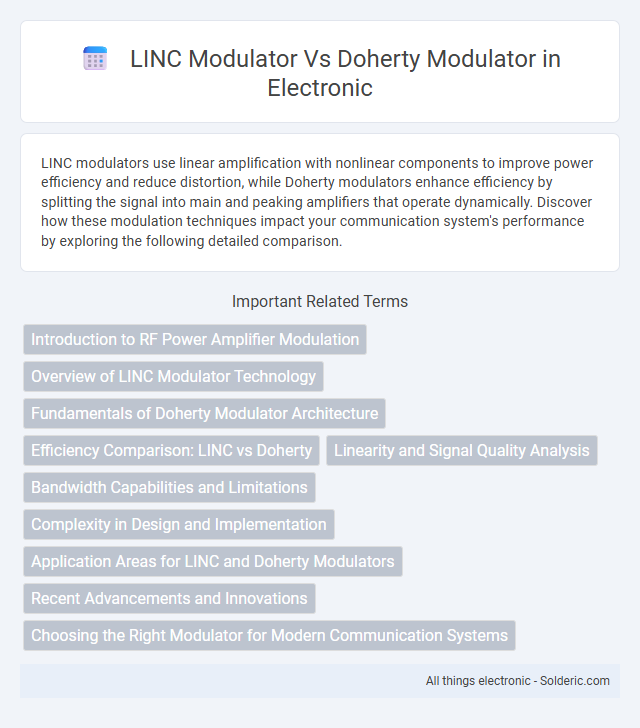LINC modulators use linear amplification with nonlinear components to improve power efficiency and reduce distortion, while Doherty modulators enhance efficiency by splitting the signal into main and peaking amplifiers that operate dynamically. Discover how these modulation techniques impact your communication system's performance by exploring the following detailed comparison.
Comparison Table
| Feature | LINC Modulator | Doherty Modulator |
|---|---|---|
| Modulation Technique | Linear Amplification using Nonlinear Components (LINC) | Load-Modulated Doherty Amplification |
| Efficiency | Moderate to High at backed-off power levels | High efficiency at backed-off power levels |
| Linearity | High linearity due to phase-modulated carriers | Good linearity, improved with digital predistortion |
| Complexity | High complexity due to baseband signal separation and combining | Moderate complexity with load modulation network |
| Power Amplifier Type | Two nonlinear PAs with phase combining | Carrier and Peaking amplifiers with load modulation |
| Typical Applications | Wideband signals requiring high linearity, e.g., 4G/5G | Base stations and RF transmitters requiring efficiency |
| Implementation Cost | Higher due to signal processing and hardware requirements | Lower relative to LINC Modulator |
| Bandwidth Support | Wide bandwidth | Moderate bandwidth, limited by load modulation network |
| Power Back-Off Efficiency | Improved efficiency across wide power back-off | High efficiency specially at 6 dB back-off |
Introduction to RF Power Amplifier Modulation
LINC modulator and Doherty modulator are advanced RF power amplifier modulation techniques designed to enhance efficiency and linearity in wireless communication systems. LINC uses two constant-envelope amplifiers operating in parallel, combining their outputs to achieve high linearity with reduced distortion, whereas Doherty employs a main and auxiliary amplifier working together to improve efficiency at back-off power levels. Both methods address the challenges of linear amplification in modern transmitters but differ significantly in architecture and performance optimization.
Overview of LINC Modulator Technology
LINC modulator technology splits the signal into two constant-envelope components, allowing for highly efficient nonlinear amplification with improved linearity. This technique contrasts with Doherty modulators, which use load modulation to enhance power efficiency but can introduce more distortion. Your choice of LINC modulators can benefit applications requiring superior linearity and power efficiency in RF transmission systems.
Fundamentals of Doherty Modulator Architecture
The Doherty modulator architecture fundamentally relies on load modulation to improve power amplifier efficiency by dynamically distributing current between the main and peaking amplifiers. It employs a quarter-wave transformer impedance inverter to maintain optimal impedance matching throughout output power variations, maximizing linearity and efficiency. This sophisticated design contrasts with LINC modulation by combining amplitude and phase control inherently within the amplifier stages rather than separating them.
Efficiency Comparison: LINC vs Doherty
LINC modulators achieve high linearity by separating amplitude and phase components, but typically exhibit lower efficiency compared to Doherty modulators due to their complex signal processing and dual amplifier paths. Doherty modulators optimize efficiency especially at back-off power levels by dynamically load-modulating amplifier stages, making them highly effective for modern communication systems requiring energy-efficient power amplification. Efficiency measurements show Doherty modulators typically reach peak efficiencies above 60% in back-off regions, outperforming LINC systems that often maintain around 40-50% efficiency under similar conditions.
Linearity and Signal Quality Analysis
LINC modulators are highly effective in achieving excellent linearity and signal quality by separating amplitude and phase components, which reduces distortion and improves overall efficiency in communication systems. Doherty modulators, while designed for high power efficiency, often face challenges in maintaining linearity under varying signal conditions, potentially leading to increased signal distortion. For your applications requiring superior signal fidelity, LINC modulators typically provide enhanced linearity and cleaner output signals compared to Doherty modulators.
Bandwidth Capabilities and Limitations
LINC modulators offer wider bandwidth capabilities by separating amplitude and phase components, which allows for efficient linear amplification over broad frequency ranges. Doherty modulators are optimized for narrow to moderate bandwidths, often excelling in efficiency at specific frequency bands but facing limitations when scaling to wider bandwidth applications. Your choice depends on whether extended bandwidth or high power efficiency within a narrower band is the priority for your communication system.
Complexity in Design and Implementation
LINC modulators exhibit higher complexity in design and implementation due to the requirement of precisely linearizing two constant-envelope signals and recombining them to maintain overall signal fidelity. Doherty modulators simplify the power amplifier architecture by employing load modulation techniques between main and auxiliary amplifiers, reducing linearity demands but increasing the intricacy of phase and amplitude control. Understanding your system requirements helps determine whether the LINC's rigorous signal processing or the Doherty's efficient amplifier design aligns better with your complexity constraints.
Application Areas for LINC and Doherty Modulators
LINC modulators excel in wideband communication systems such as satellite and military radios where high linearity and spectral efficiency are critical. Doherty modulators are widely used in cellular base stations and 5G infrastructure to improve power amplifier efficiency and reduce energy consumption. Your choice between these modulators should align with whether the priority is linearity and bandwidth (LINC) or power efficiency in high-peak-to-average power ratio signals (Doherty).
Recent Advancements and Innovations
Recent advancements in LINC modulator technology emphasize improved linearity and energy efficiency through advanced analog predistortion and digital signal processing techniques. Doherty modulators have seen innovations in load modulation networks and GaN transistor integration, significantly enhancing power efficiency and bandwidth for 5G applications. Your choice depends on requirements for spectral efficiency and amplifier linearity in modern wireless communication systems.
Choosing the Right Modulator for Modern Communication Systems
Selecting the ideal modulator for modern communication systems depends on efficiency and linearity requirements; LINC modulators excel in linearity by decomposing signals into constant envelope components, making them suitable for high-quality transmissions. Doherty modulators offer enhanced power efficiency by dynamically adjusting amplifier load, ideal for applications prioritizing energy savings in variable signal environments. Your choice hinges on balancing performance needs with system complexity and power constraints.
LINC modulator vs Doherty modulator Infographic

 solderic.com
solderic.com